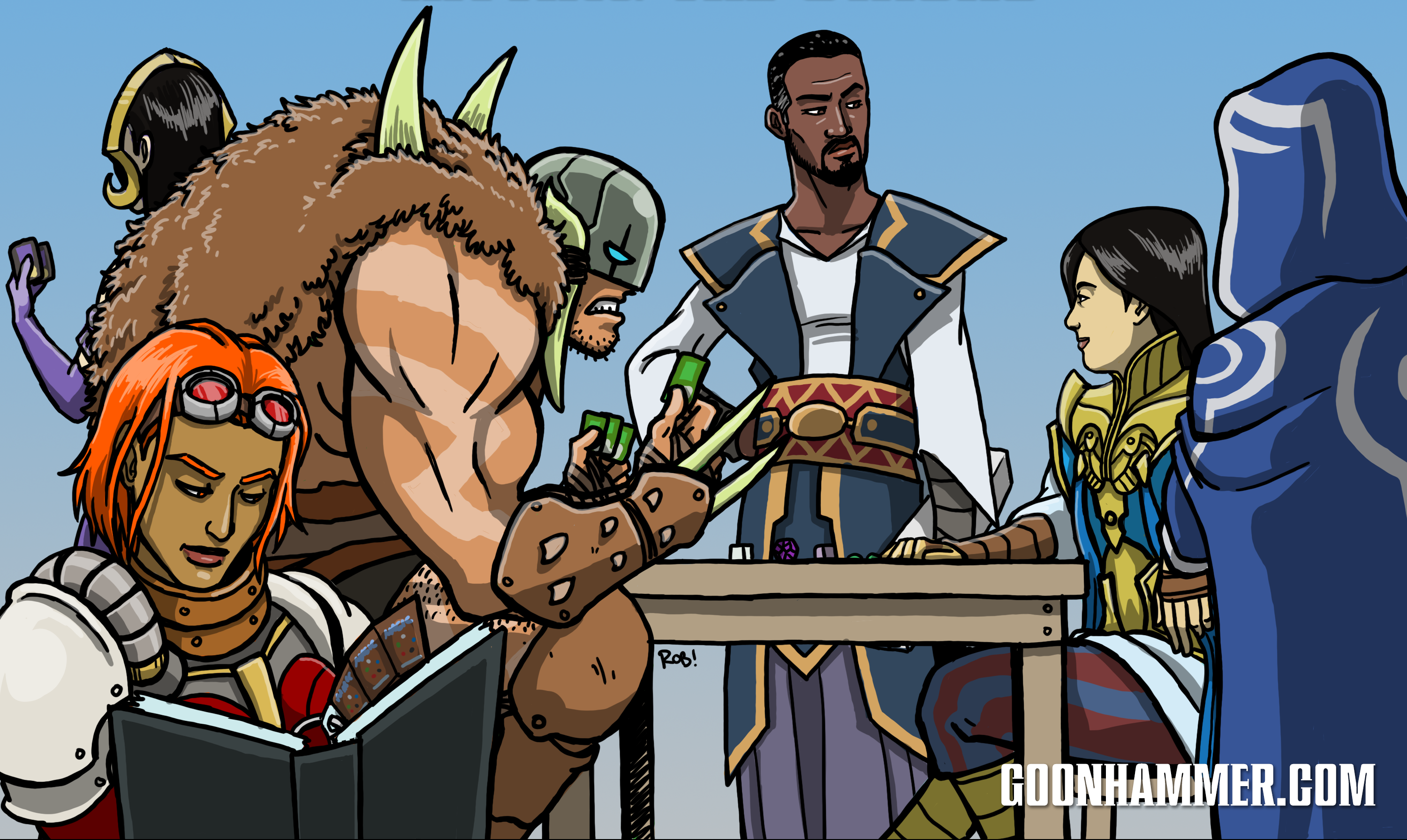In the grim darkness of the future, there is only complicated rulesets and games with 30 years of rulings and errata. Sound familiar? If you’ve seen the recently released Warhammer 40,000 crossover preconstructed decks and have wondered about the game, we’re here to give you a brief rundown of how Magic: the Gathering works, as well as how the Commander format modifies the core gameplay.
Magic: the Gathering was born in 1993, the brainchild of Richard Garfield. At its heart is a relatively simple game where two wizards battle for supremacy by summoning creatures and casting various types of spells to either hinder your opponent or help yourself. The goal – take your opponent from 20 life down to 0 life, before they take you down.
To cast your spells and summon your creatures you need mana, which is mostly obtained through “tapping” lands. Lands represent control over some sort of geographical location. By default, you can play 1 land per turn. Each turn you start by untapping everything you control. Once you tap something its resources have been exhausted until the next time it untaps. There’s a logical progression here, if you play a land on turn 1, you only have 1 mana available. On turn 2, if you play a second land, you’ll have 2, and such forth. More powerful spells cost more mana. There may be a temptation to simply run tons of powerful expensive spells, but remember the game is a race. The first play to get the other to 0 life (or out of cards in their deck) wins the game. Regardless of how many powerful creatures you’ve summoned, or binding enchantments you’ve laid on the field, once your life total hits 0, the game ends immediately. So it’s a race.
Mana is divided up into 6 types, 5 colored types, and a 6th colorless, or “uncolored”. Each color is associated with a number of themes, but two strong ones generally:
White – Order and Good
Black – Death and Evil
Blue – Water and Progress
Red – Chaos and Fire
Green – Life and Savagery
There are thus Allied and Enemy colors – White’s embrace of order is opposed by Red’s Chaos, and White’s Life is opposed by Black’s Death, and so forth.
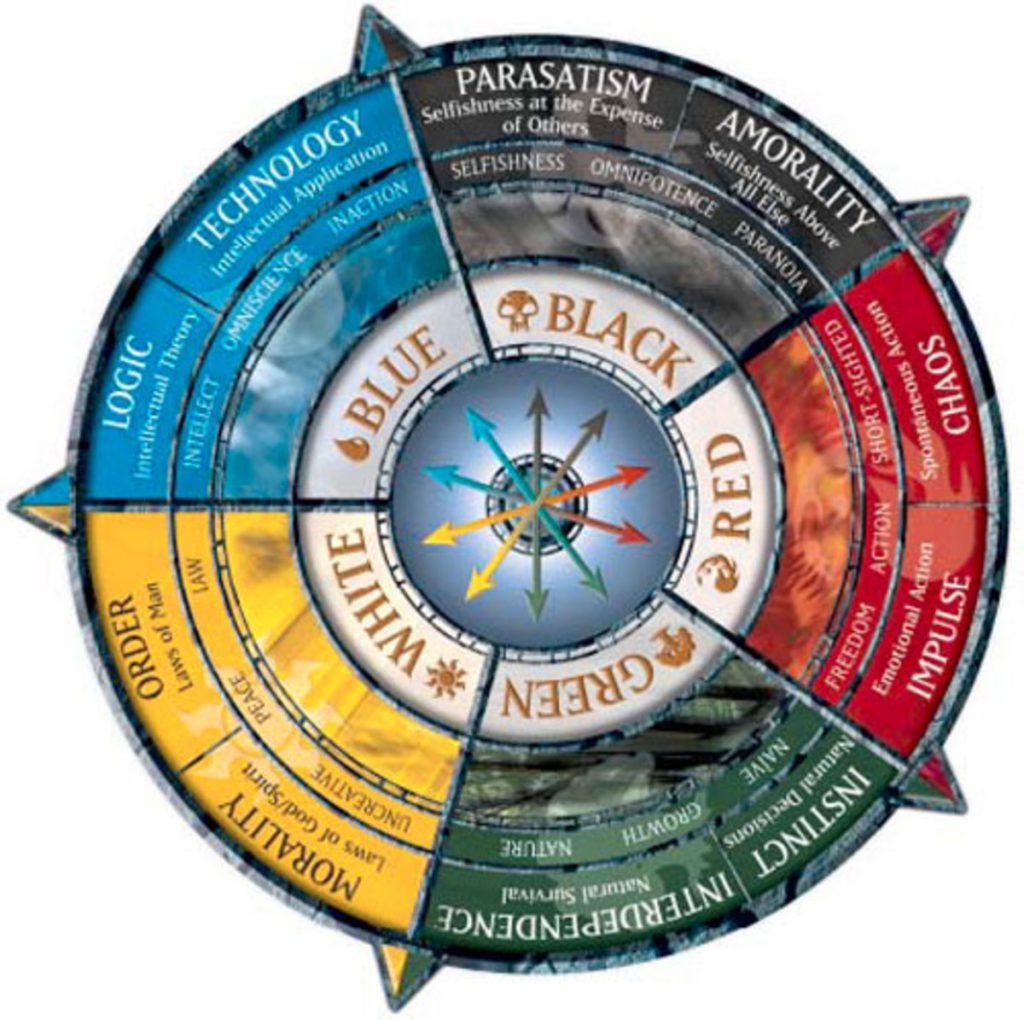
There are two kinds of “colorless” mana, mana of any color, and mana of no-color. Most spells include some component of colored and uncolored mana, perhaps a creature costs 1 green mana and 1 mana of any color. This means you could pay 1 green and 1 black, 1 green and 1 red, or 1 green and one mana of no-color, etc..
There are some some rarer spells and abilities that require mana of no-color, which is generally obtained from artifacts but there are several sources.
The Types of Spells
Permanents
Creatures: Some have utility abilities, many are designed to simply slam into the opposing wizard. Once summoned, creatures stick around until they are destroyed, at which time they go to your graveyard. There are many creatures, with many abilities. Some have abilities which occur as soon as the enter the battlefield. Others can activate small effects like mini spells. Many are designed to simply attack your opponent, or block your opponents attackers. Each creatures has two statistics – power, and toughness, in addition to their “type” such as a Bear. A typical, and very old creature:
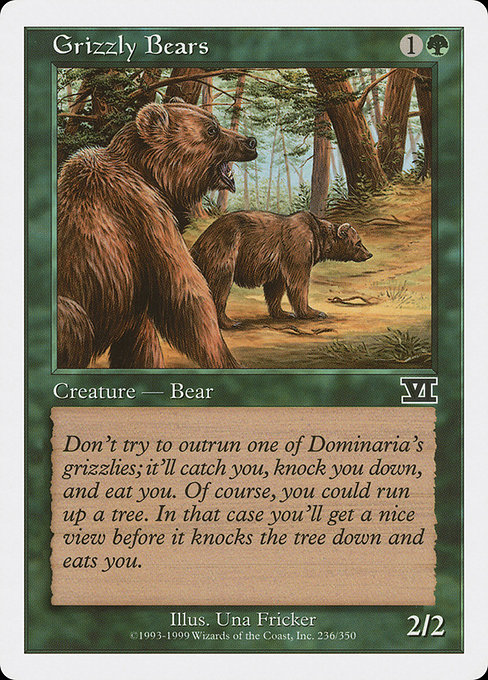
Grizzly Bears is a type Bear, with power 2 and toughness 2. Power is how much damage the creature will deal to an opposing creature that blocks them or that they block, and is also how much damage will be dealt to the opposing player if the Grizzly Bears attacks and is not blocked. The damage taken from fighting for creatures is not permanent, if the Grizzly Bears fights a Mons’s Goblin Raiders (a type Goblin 1/1) it would take 1 damage but survive. Then, it would deal 2 to the Goblin. The Goblin would die. Then, if nothing else happens, the Grizzly would heal back up to 2 toughness at the end of the turn.
Enchantments: Spells that enhance something else or change the nature of the battlefield itself; enchantments stick around until they are destroyed or removed.
Artifacts: Powerful mechanisms which can be constructed using mana, some are similar to lands, in that they tap for mana, others are more similar to enchantments and some are animated creatures like Golems that can attack your opponent.
Planeswalkers: These represent other, allied wizards coming to your aid.
Non-Permanents
Instants: Iconic spells like Lightning Bolt that simply zot a creature or a wizard or any target, at nearly any time. After an instant’s effect is felt, it does not stay in play but is placed in your graveyard.
Sorceries: Like instants, but can only be cast during your turn. Also, like instants, once they resolve, they go to your graveyard.
Lands
Not spells, but an important card type nonetheless, Lands are your basic access to resources. There are 5 types of “basic” lands, each associated with a color.
Plains – taps for 1 white mana
Swamp – taps for 1 black mana
Island – taps for 1 blue mana
Mountain – taps for 1 red mana
Forest – taps for 1 green mana
There are also “non-basic lands” that do more complex things, some have abilities, and some tap for multiple kinds of mana or multiple mana. The most common is so-called “dual-lands” which can tap for either of two colors of mana.
A typical game consists of players playing lands, and summoning creatures to attack and block each other, using their spell arsenal to protect and enhance their creatures or destroy their opponents, or simply casting direct damage spells in order to lower their opponents life total. Most games between two players with standard rules last 10-20 minutes, tops.
Players agree to rules beforehand (called formats) or to the loosest format of all – kitchen table, meaning anything goes. Most formats ban certain cards, or in older formats include a list of cards which may be restricted to playing only 1 instance of in your deck. In addition deck construction rules generally limit players to only including up to 4 of each card (except basic lands) and a minimum (but no maximum) of 60 cards in a deck.
Commander
Commander arose as a fan-created format out of players’ desire to have more prolonged, friendlier games, with somewhat complex deck construction rules.
Deck Construction
Commander is a Magic format variant based on choosing a single Legendary as a Commander for your deck. Generally, this is a creature, but it can also be a few specified planeswalkers. Your choice of Commander then determines the color identity of your deck: what cards can be included in your deck – only colors that appear as mana symbols in your Commanders casting cost or activated abilities can be used in your deck.
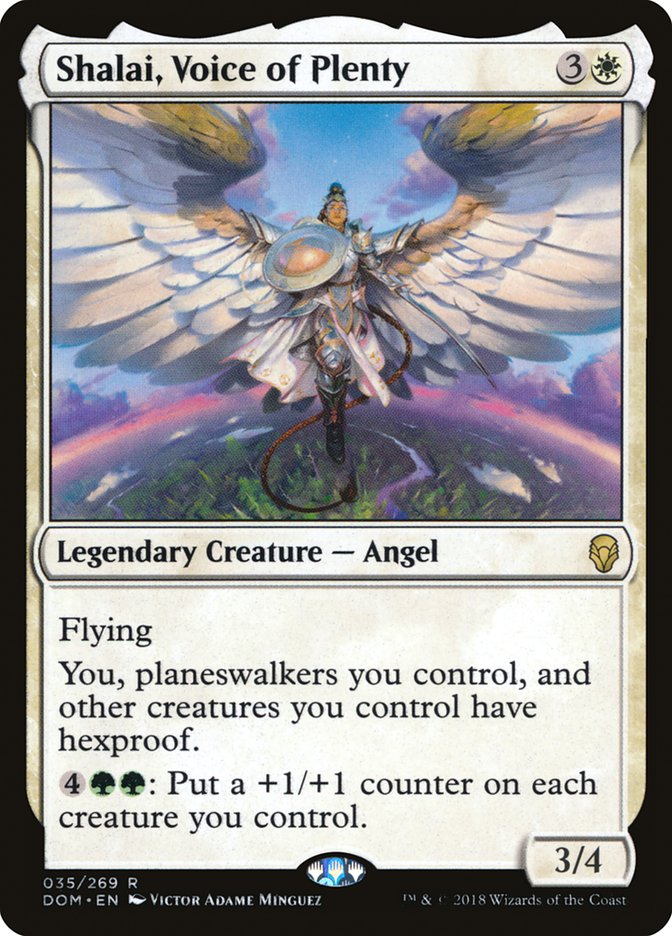
Shalai is a Commander that costs 3 of any color and 1 white but has an ability that costs 4 of any color and 2 green, will let you include white or green cards in your deck. Shalai, Voice of Plenty as a Commander can’t include any cards with red, blue or black mana pips or colored spells. Green/White is Shalai Voice of Plenty’s color identity. This includes using basic lands outside of Forest or Plains (the green and white basic lands, respectively). Islands, Swamps, and Mountains can’t be included. Or lands that tap for Blue, Black, or Red mana pips. However, you can include lands that tap for many of any color (as paradoxical as that is) so long as they don’t show the pips.
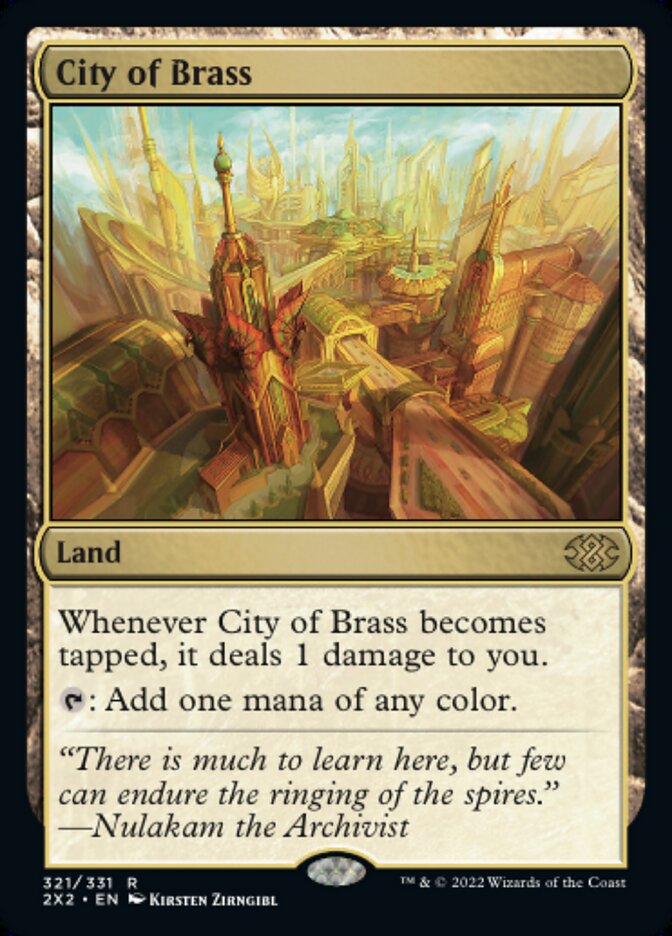
City of Brass, for example, is a-okay.
Commander is also a Highlander format, meaning instead of the usual 4 of limit, Commander decks can only include 1 of each card except basic lands (and cards that explicitly override the deck construction limit such as Shadowborn Apostle).
Commander decks consist of 100 cards, the Commander and enough cards to fill out to 100, so generally 99 cards in the deck (there are certain Commanders that have partners; so two Commanders, or Commanders with a “background” card, these decks have 98 cards).
Cards that refer to sideboards are not legal in Commander, also Conspiracy and Ante referring cards. There is also a list of banned cards in the format.
Gameplay Changes
Commander is intended to be played multiplayer, in pods of 4. Each player has a Commander and a deck of matching color identity. In order to promote a more relaxed game, players start with 40 life, rather than 20.
Your Commander begins in the Command Zone, a special zone that you can cast your Commander from without it needing to be in your hand.
Commander includes “Commander damage” – if you are dealt 21 or more combat damage (i.e. damage from a Commander attacking you and dealing damage via combat) you lose the game instantly. A viable strategy is to have a beefy Commander and just attack your opponents, often referred to as a “Voltron” deck.
When Commanders die or leave play for any reason, the owner may choose to return them to the Command Zone. Each time a Commander is cast from the Command Zone, “Commander tax” applies, which means your Commander costs 2 mana of any color more for each time it’s been cast from the Command Zone. So the first time the tax is free, then 2, 4, etc..
Cards that refer to cards you own but are not in the game do not function in commander (so-called wishes) and other cards that interact with your sideboard.
Each of the Warhammer 40k preconstructed decks is a legal Commander deck that you can play, straight out of the box. However if you purchase one and wish to start tinkering with it by adding and removing cards, you have to follow these rules to keep it a Commander legal deck.
In general, Commander is a pretty fun, chill format to play with people you’ve never met. It’s generally advisable though to have a pre-game conversation about how powerful your deck is, and what your expectations are about what turn the game will end on.
Finally, the real golden rule of Commander in my mind, is always, if you’re not having fun, or someone isn’t fun to play with, don’t play with them. You can always leave a game. And you always have the choice to just play with someone else.
